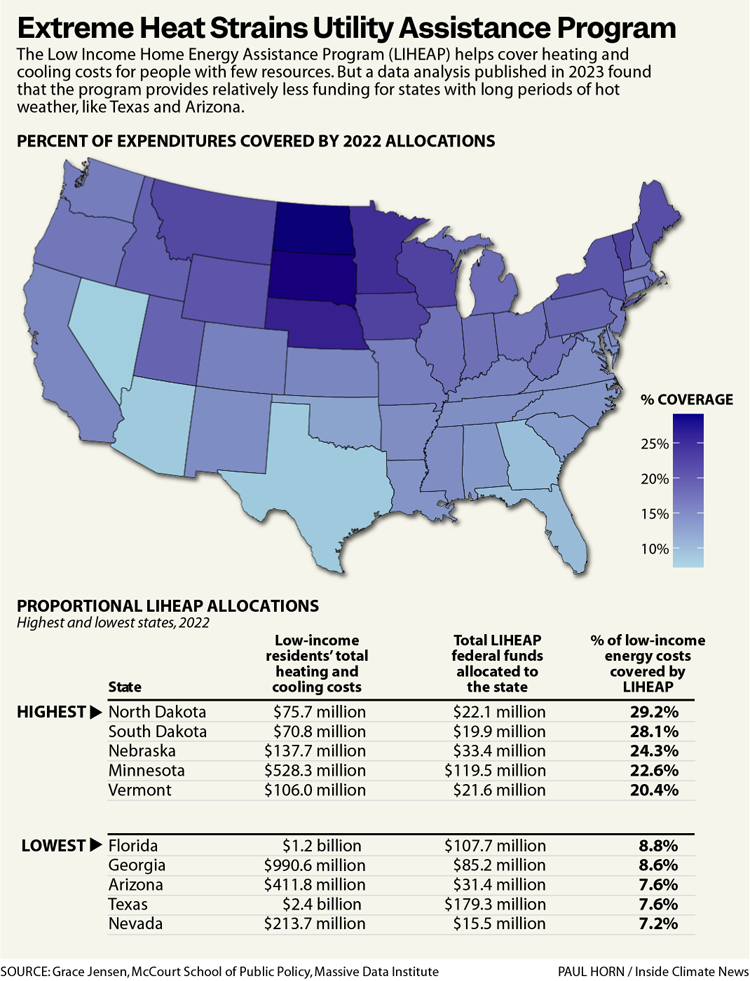In San Elizario, Texas, tucked between cotton fields and the U.S.-Mexico border fence, nearly 30 percent of the population lives below the poverty line.
When the summer heat hits here, electric bills skyrocket—and paying them is a struggle. Olivia Figueroa, executive director of the local organization AYUDA Inc., has lost track of how many people have sought help.
“Let’s say that if we get 30 calls a day, at least half of them are asking about funds to help pay their water or electric bill,” Figueroa said in Spanish. “And at the moment we don’t have any funding.”
Air conditioning is increasingly necessary to keep homes at safe temperatures during the summer—especially in states like Texas, where temperatures can exceed 100 degrees for weeks on end. That creates dangerous situations as electric bills overwhelm low-income households’ budgets. The Low Income Home Energy Assistance Program (LIHEAP) is the federal government’s answer to that, helping people keep the heat on in winter and the AC running in the summer.
But the program’s funding formula favors cold-weather climates. Advocates and researchers say that funding for LIHEAP, administered by the U.S. Department of Health and Human Services, should be increased to address the impacts of climate change and better reflect the need in hot states like Texas, Florida and Arizona.
LIHEAP, which also provides funding for weatherization to make homes more energy efficient and crisis assistance for households at imminent risk of being disconnected, was first conceived to address the rising cost of fuel oil for heating coming out of the energy crisis in the 1970s and early 1980s. Today, the program covers only 7.6 percent of low-income residents’ total heating and cooling costs in Texas, compared to nearly 23 percent of total costs in a northern state like Minnesota, according to an analysis by Grace Jensen at Georgetown University.
A Duke University study found that only 5 percent of program funds were used for cooling assistance nationwide between 2001 and 2019. Half went to heating.
“You have a program that was stamped in time during a crisis 40 years ago that hasn’t been revisited in this current moment of climate change and extreme heat,” said Diana Hernandez, a sociologist at Columbia University who studies energy insecurity in low-income communities. “It’s really to the detriment of people that endure extreme temperatures but don’t have the safety net to support them through those hard times.”
How LIHEAP Allocates Its Funds
LIHEAP, launched in 1981, at first distributed money in part based on how often a state experienced cold weather. That changed several years later after senators urged Congress to rethink the calculation.
Even so, distribution of funds still disadvantages hot states because it averages cold and hot days over a 30-year period, which doesn’t reflect how quickly the planet is warming now.
“The rules haven’t caught up with the change in temperature,” said Mark Wolfe, executive director of the National Energy Assistance Directors Association.
“How do we help low-income families stay current with their bills when the bills are going up because it’s getting hotter?”
Many states provide supplemental funding to help close the gaps. Others—like Texas—do not. “The lack of federal funding is amplified,” Wolfe said.
Meanwhile, energy bills continue to rise. The Energy Information Administration expects slightly higher costs this summer as temperatures peak in the 90s and 100s. Such an increase most affects low-income residents, who already spend at least 6 percent of their income on energy bills. Wolfe’s organization projected that average cooling costs nationwide will be $719 per household this summer—and $858 in the region that includes Texas.
“How do we help low-income families stay current with their bills when the bills are going up because it’s getting hotter?” Wolfe said. “And federal funding is not going up.”
Funding Falls Short for Extreme Heat
LIHEAP funds are disbursed in block grants to states. In Texas, the Department of Housing and Community Affairs then distributes funds to local agencies. Project BRAVO receives them in El Paso, and Laura Ponce, the organization’s executive director, stretches the money as far as possible. But it’s never enough.
A household must be at or below 150 percent of the federal poverty level to receive LIHEAP assistance. Almost one in three people in El Paso County are below that threshold, which equates to income of under $46,800 for a family of four. Recipients in Texas must certify their immigration status, so undocumented people cannot qualify for assistance.


In fiscal year 2023, LIHEAP funds only covered 5 percent of the state’s eligible population. That is likely to dip lower this year, with decreased federal funding. The 2021 American Rescue Plan and the 2022 Bipartisan Infrastructure Law provided additional money that temporarily pushed LIHEAP to $6.1 billion in fiscal year 2023. But for fiscal 2024, Congress set funding at $4 billion, despite calls from some representatives to provide more.
“Definitely more funding would be helpful,” Ponce said. “Funding that is at the level that would allow us to meet the need in the community.”
She added: “The reality is that heat kills as much as cold. So the formula shouldn’t have to be based on any particular climate.”
Unlike many states, Texas does not provide supplemental funding to help low-income households pay bills or to adjust their utility rates. A spokesperson for the Texas Department of Housing and Community Affairs said state legislators would have to authorize any additional funding. The office did not respond to questions regarding the longer periods of extreme heat Texas is experiencing.
The need is acute in communities like San Elizario, outside El Paso. Many residents live in trailers, which tend to be energy inefficient and expensive to cool. When utility assistance funds run out, AYUDA resorts to offering energy efficiency tips. The staff explains to residents how trees, insulation and caulking can help keep homes cool. But in the Chihuahuan Desert, where temperatures routinely exceed 100 degrees, those modifications can only go so far.
“I have seniors who have their air [conditioning] and they won’t turn it on because they can’t afford the electric bill later,” said Graciela Ortiz, who coordinates El Paso’s Extreme Weather Task Force. “They’ll tell me—they’re very honest—‘I’m dying in the heat but I can’t turn on the air because I can’t afford a $150 electric bill.’”
LIHEAP funds often help families catch up when they fall behind on that bill. The electric utility, El Paso Electric, suspends disconnections when the National Weather Service has issued a heat advisory, which typically occurs when temperatures surpass 105 degrees. But even if a family’s electricity is not shut off, bills continue to add up.
A utility spokesperson said a customer behind on their bills will not be disconnected if they establish a payment plan. Low-income Texas customers can qualify for a $99-a-year savings on electric bills.
This story is funded by readers like you.
Our nonprofit newsroom provides award-winning climate coverage free of charge and advertising. We rely on donations from readers like you to keep going. Please donate now to support our work.
Other states that experience extreme heat, like Arizona, report similar trends. Patricia Solis, executive director of the Knowledge Exchange for Resilience and an urban planning professor at the University of Arizona, said Maricopa County experienced over 600 heat-related deaths last year. The most at-risk residents included people who lived in older mobile homes that lacked weatherization.
And with Arizona receiving only enough LIHEAP funding to serve roughly 5 percent of eligible low-income households, Solis is concerned such preventable deaths will increase. “Arizona is way behind,” Solis said.
In March, Arizona Gov. Katie Hobbs requested Congress readjust LIHEAP’s formula, citing the state’s history of being chronically short of these “life saving funds.”
‘It’s Just Not Enough’
Researchers are taking a closer look at that formula. Some have provided new equations that would distribute funds more evenly across states. Jensen, while a graduate assistant at Georgetown last year, proposed a formula that relies on statewide heat and cooling costs across low-income families. Any leftover money would be redistributed based on energy burden. The result, according to Jensen’s report, would cover at minimum 13 percent of a state’s low-income heating and cooling expenditures.
Justin Schott of the University of Michigan’s Energy Equity Project recommended that Congress change its formula and require states to use a specific percentage of their LIHEAP allocations for cooling assistance.
“How do we plug the holes while we’re working on a better comprehensive fix?” Schott said.
In 2022 the U.S. Department of Health and Human Services released guidance encouraging states to incorporate more cooling assistance into their plans and offering other suggestions to address extreme heat. But experts say non-binding guidance is not enough to compel all states to factor in the risks of extreme heat.
“A lot of states need something that’s more firm in order to move forward with implementing meaningful changes,” said Columbia University’s Hernandez.
University of Arizona’s Solis said heat is “the number one killer” that the country will need to prepare for. “We really need to get innovative and have our systems keep up with that,” Solis added, “and LIHEAP is one of those.”
Wolfe, with the National Energy Assistance Directors Association, said program funding needs to increase across the board. Even if LIHEAP shifted funds around to more fairly support all 50 states, the money it’s splitting up is stretched thin.
“The problem is, you can move the chairs around the deck. There still aren’t enough chairs there,” Wolfe said.
LIHEAP’s block grants only serve one in six eligible households nationwide. Solis believes the heatwaves ravaging the country are evidence that more is needed.
“It’s a good program in the sense that it does strategically get dollars to support energy costs,” she said. “But it’s just not enough.”
About This Story
Perhaps you noticed: This story, like all the news we publish, is free to read. That’s because Inside Climate News is a 501c3 nonprofit organization. We do not charge a subscription fee, lock our news behind a paywall, or clutter our website with ads. We make our news on climate and the environment freely available to you and anyone who wants it.
That’s not all. We also share our news for free with scores of other media organizations around the country. Many of them can’t afford to do environmental journalism of their own. We’ve built bureaus from coast to coast to report local stories, collaborate with local newsrooms and co-publish articles so that this vital work is shared as widely as possible.
Two of us launched ICN in 2007. Six years later we earned a Pulitzer Prize for National Reporting, and now we run the oldest and largest dedicated climate newsroom in the nation. We tell the story in all its complexity. We hold polluters accountable. We expose environmental injustice. We debunk misinformation. We scrutinize solutions and inspire action.
Donations from readers like you fund every aspect of what we do. If you don’t already, will you support our ongoing work, our reporting on the biggest crisis facing our planet, and help us reach even more readers in more places?
Please take a moment to make a tax-deductible donation. Every one of them makes a difference.
Thank you,



















